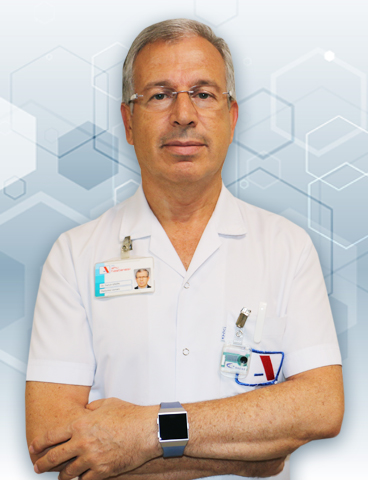

All radiological operations are performed for 7 days and 24 hours in our hospital’s radiology department. Diagnosis and treatment operations are performed with 1.5 TESLA MR, Digital Tomography, Digital Rontgen and Coloured Doppler Ultrasonography.
1.5 Tesla MR
The 1.5 Tesla GE Explorer MRI device ushers in a new era in diagnosis with its new 18-channel flex coils, new artificial intelligence-supported software, high-resolution images in a shorter time, and new functional sequences such as diffusion applications that can be applied to the whole body.
With the shortening of imaging times, patient comfort has increased, and cholangiography, angiography and urography can be performed with clearer images without holding breath in patients with poor general conditions. Breast MRI examination time has decreased from 45 minutes to 20 minutes, and Multiparametric Prostatic MRI examinations have begun to be performed without the application of an endorectal coil. Metastasis screening has become easier in Oncology patients by performing a whole body MRI examination.
With the MR ambiance application, relaxing sound and light visuals are created, and machine noise can be reduced according to the patient’s wishes.
64 Section Digital Tomography
Section Computer is one of the most advanced monitoring devices composed of an advanced computer system and roentgen tubes. It can detailly scan an average human body in 17 sec. from top to toe. And we can take 2d and 3d images from the scan results taken from this computer technique.
Coloured Doppler Ultrasonography
USG Ultrasonography is a diagnosis method which monitors visceral organs of patients using such high-frequency soundwaves cannot be heard by a human. Radiation is not used in ultrasonography. Thus, it can be used peacefully for babies and pregnants. We can examine blood flows of veins and organs with Doppler Ultrasonography method. It can be monitored that follows; arm and leg veins, veins nourishing liver, kidneys, neck veins, veins belonging to mother and fetus in pregnants, veins belonging to testicles in males, veins nourishing eyes and veining of a particular point of the body, with Doppler Ultrasonography examination. While movements of babies in mother’s womb can be monitored with delay by examining with frontal 3d ultrasonography device, also such actions of babies like frowning, smiling, gaping thumbsucking can be monitored with 4d ultrasonography in an instant and rapid way. Early diagnosis of sex, cleft palate, cleft lip, absent finger, disease-oriented from the brain and spinal cord can be performed with 4d ultrasonography device in the early stage of pregnancy. ‘Mongolism’ (Down Syndrome) can be scanned with nuchal translucency measurement in 3rd. the month of pregnancy.
DIGITAL X-RAY
The GE Tempo Pro Digital X-ray device used in our Hospital is the latest system device that the company installed in our Hospital for the first time in Turkey, and is supported by artificial intelligence. Thanks to its high defect technology our Digital X-ray device, which takes the best images by using the least X-ray, also gives early warning to Doctors in the diagnosis of some emergency diseases with the support of artificial intelligence. Digital X-ray images are saved in the computer setting and detailed evaluation is made on the images. In addition, after the results are transferred to the digital setting the patient can access the results from anywhere in the world.
Digital Mammography
Digital Mammography, which is an advanced technique for breast monitorization, has become the main diagnosis method in the diagnosis of breast disease and scanning of breast cancer. Examination time is short. Images can be monitored just 1 minute after scanning. The doses of radiation are lower than classical mammography and the image quality is higher. Just because microcalcification (unstable small calcification points) and small lesions can be noticed easily it makes the examination of fibrocystic breast tissue easier too. Images can be recorded and stored digitally. Detection of such small breast cancer mass, not having detected by hand yet in early stages, is crucial and life-saving. Mammography is advised by experts to people who is older than 40 to do annually.